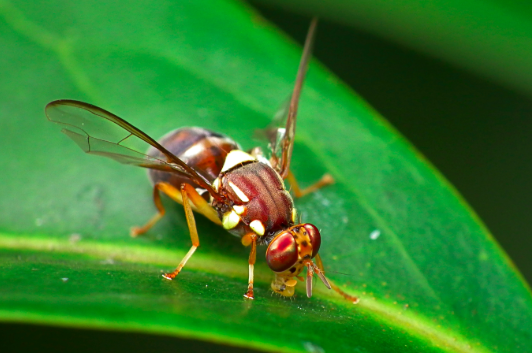Researchers study fruit flies for ways to manipulate certain enzymes and improve Alzheimer’s symptoms.
Could the cure for Alzheimer’s be unlocked by studying fruit flies? Scientists have successfully reversed the symptoms of Alzheimer’s disease in fruit flies, a new study reports. By adjusting the levels of just two enzymes, the symptoms of Alzheimer’s disease went away, and the flies were able to remember behaviors they previously learned.
Scientists from Drexel University looked at what happens in the early stages of Alzheimer’s, usually before it’s diagnosed. Two enzymes, called HDAC2 and Tip60 HAT, have been tied to difficulties with learning and memory. When HDAC2 is too high, it overwhelms Tip60 HAT, the enzyme it pairs with, and represses how the genes that control learning and memory are expressed.
By adjusting the levels of just two enzymes, the symptoms of
Alzheimer’s disease went away, and the flies were
able to remember behaviors they previously learned.
For this study, researchers trained flies to associate a certain odor with table sugar, which they eat. Eventually, the scent had a Pavlovian effect on the flies—they would move toward the scent even if sugar was not present. Some of the flies were genetically modified to have symptoms of Alzheimer’s, and those flies could no longer remember to go toward the scent as the symptoms progressed. But when the researchers added extra Tip60 HAT to balance the presence of HDAC2, the flies with Alzheimer’s were able to remember to find their way.
“Our findings strongly support the concept of exploring the efficacy of specific Tip60 HAT activators, as well as identifying and manipulating additionally misregulated Tip60 target genes,” said Felice Elefant, Ph.D., an associate professor at Drexel.
“Our findings strongly support the concept
of exploring the efficacy of specific Tip60 HAT activators,
as well as identifying and manipulating
additionally misregulated Tip60 target genes.”
Changes in how genes are expressed are called epigenetic changes, and enzymes like Tip60 HAT and HDAC2 are called epigenetic enzymes. These changes happen early in Alzheimer’s disease, before scientists have a chance to observe them in human brains, because most human brains with Alzheimer’s are only seen after death. When the researchers looked at Tip60 HAT in post-mortem human samples, they noticed it was elevated in brains with Alzheimer’s.
“Many researchers that study Alzheimer’s disease utilize human post-mortem samples, and thus, they are not looking at what is happening during the early progression of neurodegeneration, including whether we can correct what is happening during these early stages,” said Elefant.
The hope is that scientists may one day be able to correct unbalanced enzymes that lead to the repression of how learning and memory genes work.
The hope is that scientists may one day be able to
correct unbalanced enzymes that lead to the
repression of how learning and memory genes work.
“When people age, they have a loss of memory, but it’s not because there are mutations in their genes,” Elefant said. “It’s the way they’re packaged. They’re distorted. And we’re seeing non-invasive ways we might be able to prevent that early on.”
This study was published in the Journal of Neuroscience.


